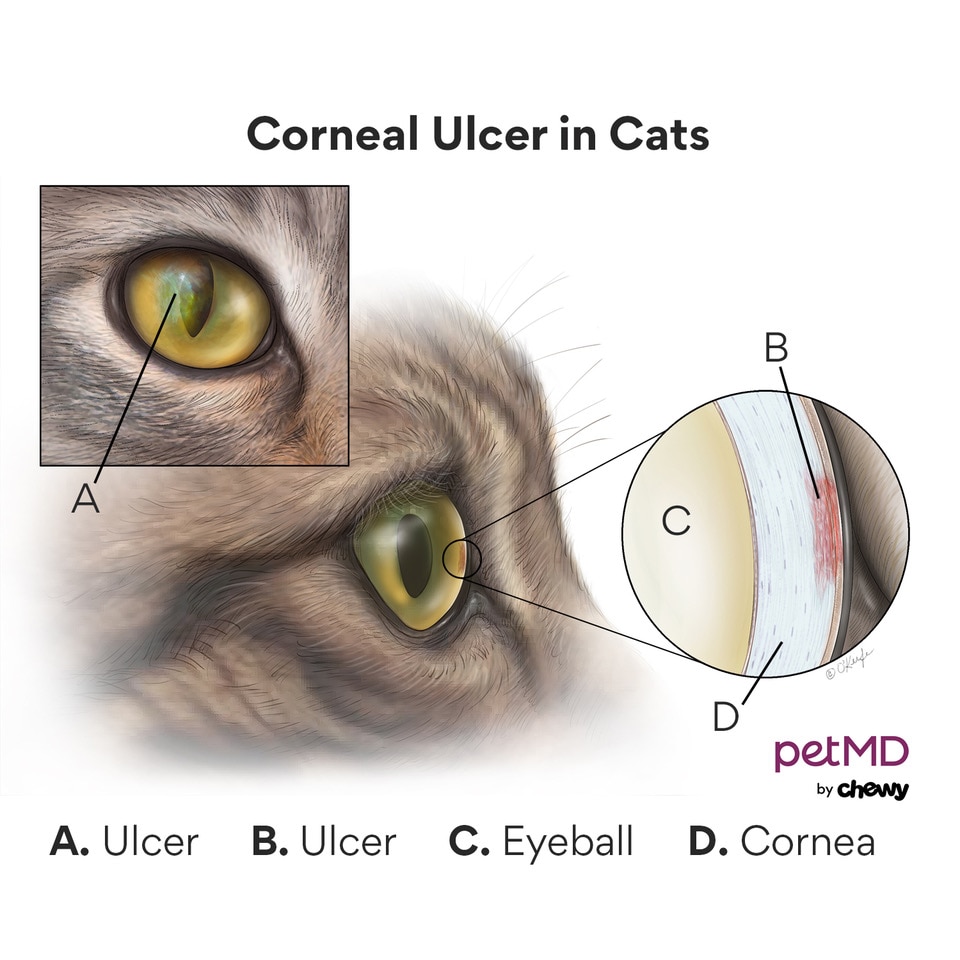Corneal Ulcers in Cats
What Are Corneal Ulcers in Cats?
The cornea is the clear outer membrane that protects the front of the eyeball. It is made up of three layers that are all transparent.
When one or more of these layers is damaged structurally, such as a hole or a scratch, it’s known as a corneal ulcer. It can also be called a corneal abrasion or erosion.
There are varying levels of severity with corneal ulcers in cats, classified to their depths and severity.

Health Tools
Not sure whether to see a vet?
Symptoms of Corneal Ulcers in Cats
Corneal ulcers in cats are very painful.
Symptoms and signs of a cat corneal ulcer include:
-
Rubbing the affected eye with their paw or against furniture or the floor
-
Redness (can be difficult to notice because they will keep their eye squinted)
-
Squinting/tightly shutting their eye
-
Eye discharge may or may not be present
Causes of Corneal Ulcers in Cats
Trauma in one form or another is the cause of most corneal ulcers. Trauma can look like a foreign body in the eye, or it can be something much more innocuous.
Tear-production conditions and eyelid abnormalities can also be responsible for corneal ulcers in cats.
How Vets Diagnose Corneal Ulcers in Cats
After the veterinarian’s physical exam and close ophthalmic and neurological exams, the veterinarian will conduct a few tests for the eye.
One test measures tear production, called a Schirmer tear test. The intraocular pressure will also be checked. Tear test breakup team (the rate which the tear film evaporates) may also be checked.
The fluorescein dye application (a fluorescent dye) will be the most effective test at your vet visit when a corneal ulcer is to be blamed for your cat’s squinting eye. With this test, a special dye will be applied, taken up by certain layers of the cornea, and gently flushed out.
The veterinarian will then be able to see if any dye remains as it glows neon green. They will likely be happy to show you the bright green glow, so you can see the corneal scar with your own eyes.
For complex ulcers, advanced samples may be needed for examination.
Treatment for Corneal Ulcers in Cats
The goal of treatment is to stop the loss of the corneal cells and prevent the cornea from further rupturing. Eliminating pain is also a cornerstone of treatment.
Other therapies are aimed at encouraging the cornea to repopulate the damaged cells while minimizing scarring. The topical application of the cat’s own serum (this will be prepared in-house just for your cat) is often helpful to encourage healing.
Any concurrent infection must also be treated. The application of medications will be several times a day in all likelihood.
If the ulcer is complex, surgery may be recommended to promote healing. Many of these procedures can be done by your primary care veterinarian. If the ulcer exceeds 50% or more of the depth of the cornea, or if the ulcer is nonresponsive to treatment, referral to a board-certified veterinary ophthalmologist is recommended. Surgery may be necessary.
Recovery and Management of Corneal Ulcers in Cats
Rechecks for corneal ulcers in cats are crucial; if a simple corneal ulcer is not improving in five days, it becomes classified as a complex ulcer, and treatment must ramp up accordingly. Because this is such a short time frame, your veterinarian will likely want to do the first recheck before this period is over.
A recheck within two to three days is not uncommon to ensure the ulcer is improving.
Corneal Ulcers in Cats FAQs
Can a cat eye ulcer heal on its own?
No. Without treatment, corneal ulcers are at risk for rapidly worsening, and they can “melt” away the affected part of the cornea.
How long does it take for a corneal ulcer to heal in cats?
Depending upon severity, one to eight weeks after being treated by a vet. They will not heal on their own.
What does a corneal ulcer look like in a cat?
Your cat will have a reddened, painful eye and will be squinting or rubbing at their eye.
Help us make PetMD better
Was this article helpful?
